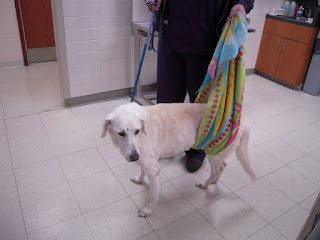
WHERE STATE-OF-THE-ART MEETS STATE-OF-HEART
WE HAVE A FUNDAMENTAL COMMITMENT TO EXCELLENCE IN VETERINARY MEDICINE AND COMPASSIONATE CARE
OUR WELL-EDUCATED TEAM IS COMMITTED TO ENHANCING THE HUMAN-ANIMAL BOND
WE BELIEVE PETS ARE NOT JUST ANIMALS, BUT INTEGRAL MEMBERS OF OUR FAMILIES
WE ADHERE TO THE HIGHEST ETHICAL AND MEDICAL STANDARDS BEFITTING OUR COMPANIONS,
WHILE MEETING AND EXCEEDING OUR CLIENTS' EXPECTATIONS
Wednesday, March 28, 2012
Understanding Canine Vestibular Syndrome

Thursday, March 22, 2012
Calming Clothing for Anxious Pets

Thursday, March 15, 2012
Toxoplasmosis
Toxoplasmosis is an example of a disease that can be transmitted between animals and humans, also known as a zoonotic disease. The disease is caused by the single-celled parasite Toxoplasma gondii. Officials at the Centers for Disease Control and Prevention (CDC) estimate that as many as 60 million people in the United States are infected with this parasite. Fortunately, most Toxoplasma gondii infections are kept under control by the immune system, provided that the infected person is otherwise healthy. People with compromised immune systems and children under 5 are particularly at risk of developing more serious symptoms and should seek medical treatment if toxoplasmosis is suspected. Women who are pregnant should also be especially cautious because toxoplasmosis can be dangerous to the unborn fetus.
As illustrated in the diagram below, the parasite that causes toxoplasmosis is commonly carried by cats, rodents, and other animals. Cats can become infected by eating infected rodents, or undercooked meat that is infected.

Humans can also become infected by eating undercooked meat. Additional hazards include accidental ingestion of cat feces (from the litter box or garden soil), blood transfusion, or organ transplant.
How Can I Avoid Toxoplasmosis?
To avoid toxoplasmosis, make sure to wash your hands with soap and warm water after handling raw meat or cleaning your cat's litter box. It is also important to wash your hands well after gardening, and to make sure fresh vegetables are thoroughly washed before consuming them. Avoid eating undercooked meat, and do not feed undercooked meat to your cat. Keep cats and other animals out of children's play areas. If you have a sandbox outside, keep it covered when not in use. Clean the litter box daily as Toxoplasma gondii does not become infectious until 1 to 5 days after it is shed in the cat's feces. If you are pregnant or immunocompromised do not clean the litter box. If no one else is available to do the chore, wear disposable gloves and wash your hands well with soap and warm water. It is also a good idea to keep your cat inside and avoid holding new cats or kittens if you are at higher risk for toxoplasmosis.
Will Toxoplasma Make My Cat Sick?
Like humans, most cats do not show symptoms following an infection with Toxoplasma gondii. If your cat becomes infected, the parasite will be shed in your cat's feces for a few weeks, after which time the infection should resolve on its own. If your cat is already infected with another disease such as feline leukemia, feline infectious peritonitis (FIP), or feline immunodeficiency virus (FIV) it will be at greater risk of developing more serious symptoms of toxoplasmosis. These cats should be kept indoors to avoid a concurrent Toxoplasma infection. If you are concerned about your cat's health, see your veterinarian, or come see us here at Veterinary Associates of Cape Cod
Wednesday, March 7, 2012
Veterinary Rehabilitation
- Osteoarthritis
- Obesity
- Vestibular disorders
- Hip or elbow dysplasia
- Cruciate injuries
- Back injuries
- Fractures
- Tendon, nerve, or muscle injuries
- Patellar luxation

Thursday, March 1, 2012
Dealing With the Loss of a Pet
